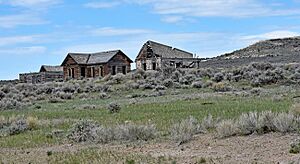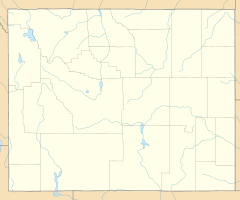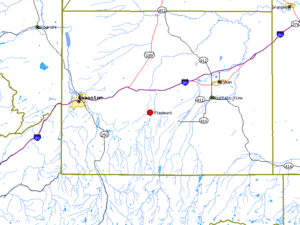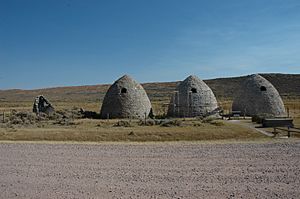Piedmont, Wyoming facts for kids
Quick facts for kids
Piedmont, Wyoming
|
|
|---|---|

Abandoned buildings at Piedmont
|
|
| Country | United States |
| State | Wyoming |
| County | Uinta |
| Time zone | UTC-7 (Mountain (MST)) |
| • Summer (DST) | UTC-6 (MDT) |
Piedmont is a fascinating ghost town located in Uinta County, Wyoming, United States. It was once a busy town, important for the Union Pacific Railroad and its timber industry. However, it slowly became a ghost town when the railroad built a new line that went around it.
Contents
Where is Piedmont?
Piedmont is found in the southwestern part of Wyoming. Its exact location is about 41 degrees North and 110 degrees West. This area is known for its rugged and beautiful landscapes.
Sometimes, maps might show different coordinates for Piedmont. This is because many sources point to Fort Bridger, which is the closest larger town.
The Story of Piedmont
Piedmont was settled around 1867. Its main purpose was to provide railroad ties for the new Union Pacific Railroad. These ties are the wooden beams that support the railroad tracks.
Early Settlers and Naming the Town
Two important pioneers, Moses Byrne and Charles Guild, helped start Piedmont. They were both Mormon settlers. Moses Byrne built special ovens called kilns to make charcoal. Charles Guild started one of the first ranches in the area.
The area was first called "Byrne." But people often confused it with another place called Bryan Station. So, the name was changed to Piedmont. This new name came from the Piedmont region in northern Italy. Moses Byrne's wife, Catherine Cardon, and Charles Guild's wife, Marie Madeleine Cardon, were sisters from small towns in that Italian region.
The Guild family joined the Byrne family in 1866. They had traveled from Salt Lake City. As the transcontinental railroad moved through western Wyoming, it needed a place for wood and water. A perfect spot was found near the Muddy River station. Moses Byrne was asked to manage this new station.
A Busy Railroad Town
Piedmont started as a "tent camp" for the railroad workers. It probably had its largest population during this time, even though there were only about twenty homes. This tent town was a base for workers building the railroad up a steep mountain to Aspen Station.
The railroad route had many sharp turns, including a big horseshoe bend. By 1868, railroad crews arrived to lay the tracks. They soon realized that extra engines, called "helper engines," would be needed to push trains up the 8-mile steep slope.
Wells were dug to provide plenty of water. Sidings (extra tracks), an engine shed, and a water tank were built. Piedmont became a key stop for refueling these helper engines with wood and water. More families moved to Piedmont as more men were needed to run the engines. Homesteaders also arrived. The Guild family opened a store, and the town even had four saloons!
The Charcoal Kilns
The logging industry also grew in Piedmont. Moses Byrne built five charcoal kilns in 1877. These kilns cost about $1,500 to build. Workers used ox teams to haul aspen and pine logs to the kilns. There, the wood was burned to make charcoal. The Union Pacific Railroad Company used this charcoal to heat its passenger cars.
Today, three of these original Piedmont Charcoal Kilns still stand. They were added to the National Register of Historic Places in 1971 because of their historical importance.
Why Piedmont Became a Ghost Town
Around 1910, the Union Pacific Railroad started digging a new tunnel. This was the Aspen tunnel, which was about one and a half miles long. When the tunnel was finished, it meant trains no longer needed to climb the steep, winding path from Piedmont to Aspen Station.
The railroad track was rerouted to go from LeRoy directly to the new tunnel, completely missing Piedmont by several miles. Piedmont was left behind, and its decline began.
By 1940, there wasn't enough business to keep the old Guild Mercantile Store open, so it closed. Over the years, most of the buildings were moved away or fell apart. Today, only a few old homes, some foundations, the coal dump, Moses Byrne's charcoal kilns, and the cemeteries remain. Piedmont is a quiet reminder of a once-busy railroad town.
Images for kids






